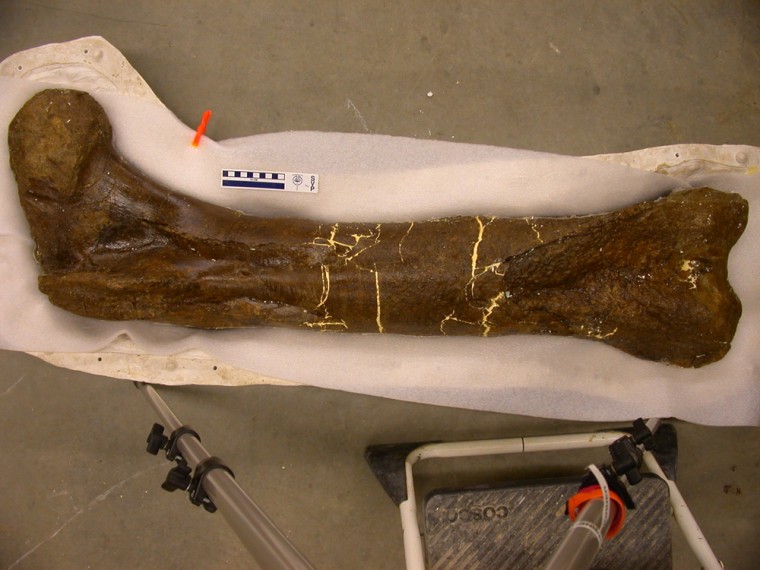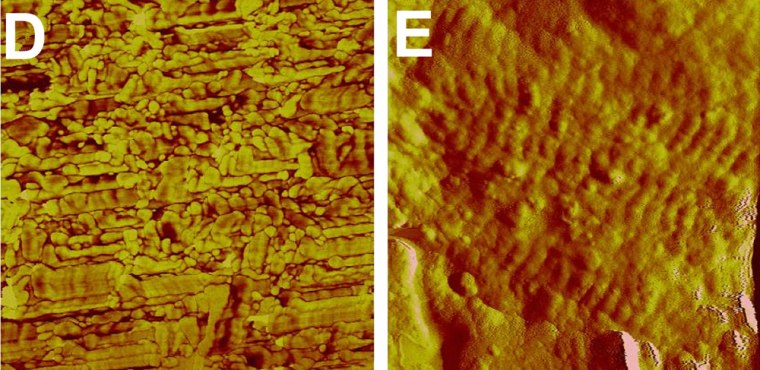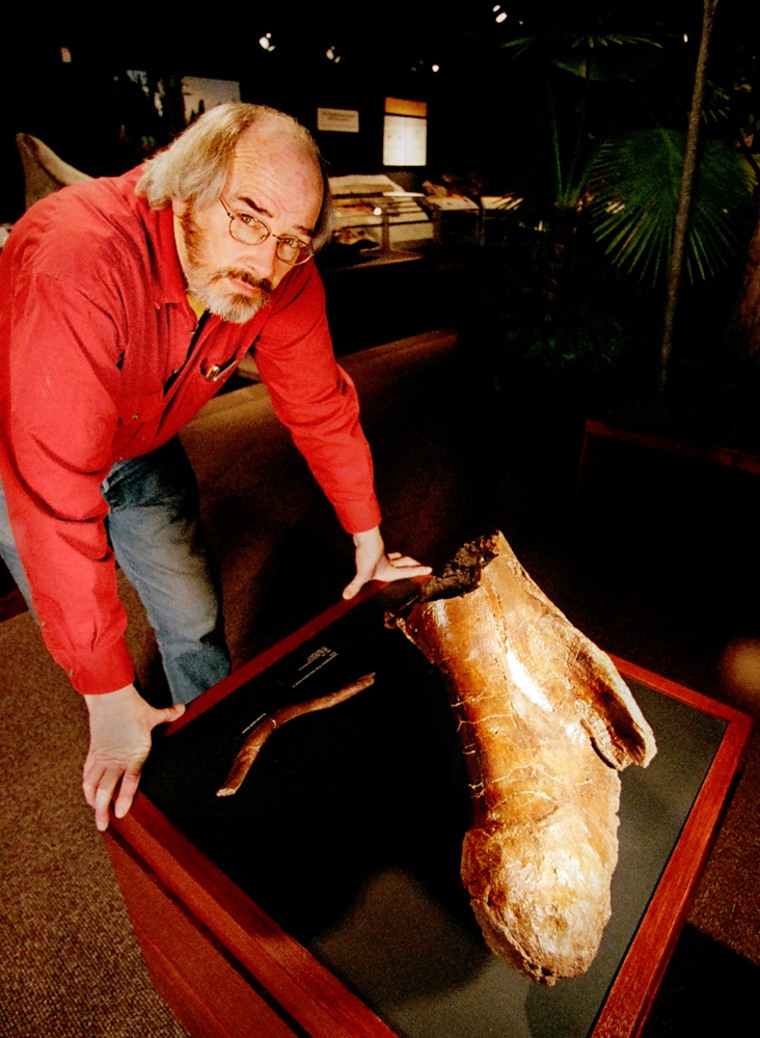For the first time, researchers have read what they say is the biological signature of a tyrannosaur — a signature that confirms the increasingly accepted view that modern birds are the descendants of dinosaurs.
The signature doesn't come from studying the shape of the 68 million-year-old dinosaur's fossilized bones, but from analyzing the organic material found inside those bones. It's not DNA — despite what you've seen in movies like "Jurassic Park," that genetic material couldn't be recovered. But researchers say it's the next-best thing: collagen proteins that were isolated using techniques on the very edge of what's possible today.
Those techniques, detailed in Friday's issue of the journal Science, could open up "a new window into an entirely new approach" for paleontology, one expert told MSNBC.com. What's more, researchers say the methods are already being incorporated into improved tools for detecting present-day diseases.
“We don’t know what the possibilities are,” said Mary Schweitzer, a paleontologist at North Carolina State University and the North Carolina Museum of Natural Sciences who was one of the principal authors behind the studies. “We’re starting right now with a particular goal in mind, but the spin-offs … how this might apply to human health and our understanding of disease … all of that is yet to be seen.”
Schweitzer and her colleagues emphasized that the protein analysis was just the first step in what could become a worldwide effort to categorize extinct species according to their molecular makeup. Famed paleontologist Jack Horner, another member of the research team, said he would embark on a world-girdling series of expeditions this summer to see if further samples could be found.
“All of our morphological hypotheses based on fossils need to be tested. Every one of them,” said Horner, a paleontologist at Montana State University and the Museum of the Rockies.
Tale of a T. rex
The tale of the T. rex began with Horner, back in 2003: He and his team found the tyrannosaur's massive leg bone beneath 1,000 cubic yards of rock at the Hell Creek fossil site in Montana, but had trouble fitting the bone inside their helicopter for the airlift back to the lab.
When they broke the bone into pieces for transport, they were amazed to find that some of the dinosaur's soft tissues appeared to be preserved within. Previously, paleontologists had thought all the tissues of a fossil turned to minerals over the course of millions of years.
After analyzing the tissues under a microscope, Schweitzer reported in 2005 that they looked similar to the cells and blood vessels found in ostrich bones. But at that time, "we could not directly address what that material was made of," she said during a teleconference with journalists this week.
Schweitzer suspected that some of the material was preserved collagen protein — which is the main organic constituent of bone, left behind when the minerals are removed. She said the material looked like collagen, and it reacted like collagen when chicken antibodies were applied to a sample.
But to confirm her suspicions, Schweitzer turned to John Asara, a specialist in mass spectrometry at Harvard Medical School and Beth Israel Deaconess Medical Center. Mass spectrometry is a technique for identifying minute quantities of a substance by measuring its atomic properties, molecule by molecule. Asara and Schweitzer had worked together previously to isolate protein sequences from mammoth remains that dated back 100,000 to 300,000 years.
The T. rex task was much more challenging: After removing the minerals and impurities from the bone samples that Schweitzer provided, Asara had less than a billionth of a gram of protein to work with. Nevertheless, he and his colleagues were able to decode seven strings of protein molecules. Those sequences were compared with a large database of collagen data — including sequences that Asara and his team isolated from a modern ostrich and from mastodon bone fragments that were 160,000 to 400,000 years old.
Scientists hit protein paydirt
The researchers took pains to make sure that they had the right sequences to compare, going so far as to create and analyze synthetic proteins that were modeled on the natural proteins in order to check their results. The 74 mastodon sequences were closely related to sequences from the bones of mammalian species, ranging from humans to elephants — but four of them appeared to be unique to the mastodon, Asara said.
In contrast, Asara's team had only those seven T. rex protein sequences to work with, and it turned out all of them matched up with modern-day sequences.
"Out of seven total sequences, we had three that matched chicken uniquely," Asara told reporters. "We had another that matched frog uniquely, one that matched newt uniquely, and a couple that matched multiple sequences."
The bottom line was that the T. rex's biological signature was most like a bird's, at least based on the first fragmentary data. "It looks like chicken may be the closest among all species that are present in today's databases for proteins and genomes," Asara said.
One reporter even wondered whether roasted T. rex might have tasted like chicken. "That could be true," said Asara, going along with the joke.
The researchers said they were heartened to see that different sequences matched the unique signatures of more than one species. That "pretty much convinced us this was very unlikely to be due to contamination," Asara said.
Linkage to birds ... and more?
The close link to birds was also reassuring, said Thomas Holtz, a paleontologist at the University of Maryland at College Park who was not involved in the research but was familiar with the findings. "It would be totally astonishing if it were any result but that," he told MSNBC.com.

Like other paleontologists, Holtz said the most significant aspect of the newly published findings was what they promised for the future: the application of molecular biology to a field that in the past has been based solely on fossils in rocks. He stressed that the true power of the technique would come into play when other samples can be analyzed.
"Once more of them get sampled, then we can start being able to compare the extinct with the extinct," he said. "Then they could really support, or overturn, previous hypotheses. The results of this paper aren't so much that they have made an important contribution to our understanding of T. rex or mastodons, but rather that they are opening a window into an entirely new approach to these fossils."
Horner told journalists that the findings already have strengthened the dinosaur-bird connection: "It's the first way we can test the hypothesis of relationships. ... This is a test, and we have failed to falsify that dinosaurs and birds are related. It changes our hypothesis to a theory now."
There'll be some changes made
The successful test could lead to changes in the way fossil-hunters do their work. Schweitzer and her colleagues speculated that the tissue within the Hell Creek leg bone was so well preserved because the fossil was created in sandstone, where water and chemicals that might have destroyed the proteins could leach away more easily. Also, Horner's team did not apply preservatives to the broken bone that might have destroyed the proteins.

"The big issue here is that these are special fossils," Phil Andrews, an expert on protein analysis at the University of Michigan, told MSNBC.com. "These Hell Creek fossils are exceptionally well preserved, and that's what makes this possible."
Horner's expedition, involving more than 100 people on nine field crews, would be aimed at finding other fossils that fit the specifications for biological samples. "We're going worldwide looking for exquisite preservation ... looking for specific specimens that are deep in sediments," he told reporters. He said the first sites on his list were Hell Creek and Mongolia's Gobi Desert.
Andrews said Asara's team employed some innovative methods to construct the synthetic sequences that could be used for comparison. Those methods — as well as the search-engine techniques developed for matching up the T. rex sequences — could have wide application to other fields of study, including evolutionary biology, Andrews said.
Peggy Ostrom, a zoologist at Michigan State University and a pioneer in sequencing the proteins of extinct species, emphasized that the field was still only in its infancy. She told MSNBC.com that the current effort was like trying to reconstruct the contents of an entire newspaper from just a couple of scraps.
"What we need to do is accumulate these mass spectra in huge repositories, like , so we can compare those small differences, and start developing an understanding of these evolutionary relationships," Ostrom said.
Medical implications
The research has implications for human health as well, said Lewis Cantley, a colleague of Asara's at Harvard and Beth Israel Deaconess and a co-author of the Science research. He explained that the mass spectrometry technique was initially used to develop new protein-based tests for prostate cancer and other diseases — and the advances made in the course of the T. rex analysis would feed back into that effort.
"We're hoping that one can actually pick up mutations in the proteins that would infer what the DNA mutations were," he said. That could lead to new tests for catching cancer at the disease's earliest stages.
Asara said there were already experiments applying the new techniques to human diseases, although he didn't go into detail.
"We are finding mutations at the protein level," he said. "The bioinformatic technology that was developed for the fossil is being applied to human disease."
In addition to Schweitzer, Horner, Asara and Cantley, the researchers involved in the Science studies included Zhiyong Suo, Recep Avci, Mark Allen and Fernando Teran Arce of Montana State University in Bozeman; and Lisa Freimark and Matthew Phillips of Beth Israel Deaconess Medical Center in Boston. The teams received financial support from the National Science Foundation and the David and Lucille Packard Foundation. In addition, Schweitzer had support from NASA, Horner had support from software executive Nathan Myhrvold, and Asara had support from the Paul F. Glenn Foundation.
